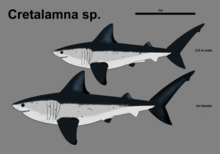|
Anaipadi Formation
The Anapadi Formation is a gelogical formation dating back to the Late Cretaceous Period ( Coniacian ) of India.[1] DescriptionThe Anaipadi Formation preserves fossils from a neritic environment (the relatively shallow part of the ocean above the drop-off of the continental shelf).[1] The upper portion of the unit, which is marked by the presence of the ammonite Kossmaticeras theobaldianum.[2] The Anaipadi Formation preserves a rich mollusc fauna.[1] including common fossils of ammonites and inoceramids, as well as brachiopods.[3] Fossils of marine reptiles have also been found, although they are rare.[1] It has been suggested that the abundant brachiopods and inoceramids in the upper Anaipadi Formation indicates a transgressive environment.[3] In addition to the marine life found in the upper Anaipadi Formation, terrestrial matter was in the area evidently prone to being carried out to sea. Among other finds recovered in the unit are for instance a large amount of petrified wood.[3] The presence of large quantities of wood indicates that land with dense vegetation was located relatively close a marine environment[2] Fossil ContentRare fossils of Marine Reptiles are found in the Anaipadi formation as well.[1]
The formation also contains fossils of other ammonites, inoceramids and brachiopods.[3] References
|
|||||||||||||||||||||||||||||||||||||||||||||||||||||||||||||||||||||||||||||||||||||||||||||||




